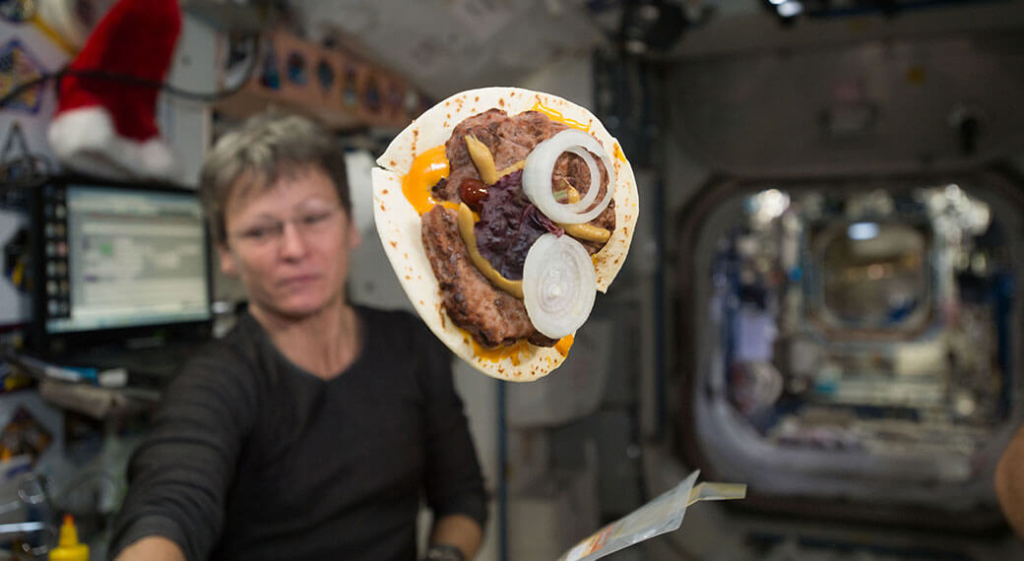In 1961, NASA tested whether the human body was capable of peristalsis — the involuntary muscle contractions necessary to move food though our digestive tracks — in a microgravity environment. Fast forward to today and we have Michelin-starred chefs preparing four-course meals for our astronauts in orbit, as well as space tourism.
As it turns out, masterful culinary skills are needed both on Earth and in orbit. This article looks at the food challenges that come with feeding astronauts in space. Then, we’ll look at two recent innovations in the foodservice industry that could potentially help astronauts travel further than ever before.
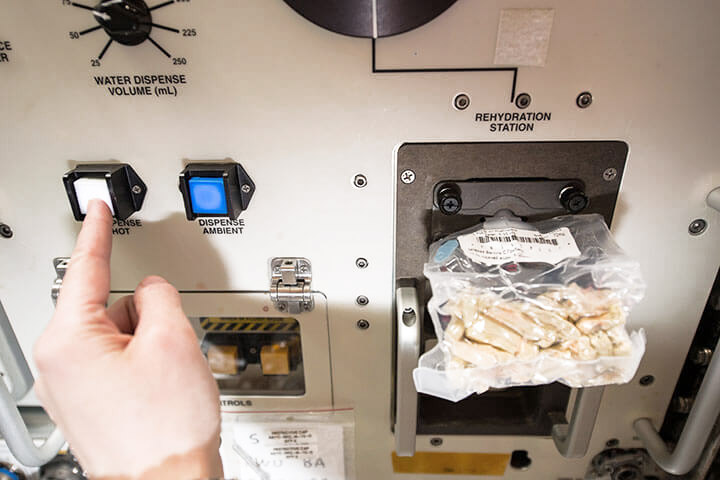
Microgravity Challenges
Space cuisine has progressed in leaps and bounds in a small amount of time, from whether it was possible to even swallow food in a gravity-free environment to whether if it was possible for Alain Ducasse to serve Riviera-style swordfish aboard a space mission. This gastronomic niche, however, poses unique logistical challenges that we don’t face on Earth. As you will see, complex problems emerge when you remove gravity from the equation. Here are just a few of them:
Nutrition
Astronauts face myriad challenges to keep themselves healthy during a mission. For starters, muscle mass, red blood cells, and bone density decrease in space. The loss in bone density, for example, is only one of many reasons that the nutritional content of space food is so important to the health of the astronauts and the mission itself.
As we take a closer look at why bone loss occurs in microgravity environments, we discovered that the human body’s need for skeletal support dissipates when there is little to no downward force for the body to resist. Astronauts lose 1% to 2% of their bone density for every month they spend in space, which creates an obstacle for longer missions. And in the case of a trip to Mars, which could easily take three years, that amounts to 36% – 72% bone loss.
Dulled Sense of Smell and Taste
What tastes good on Earth isn’t what necessarily tastes good aboard a space mission. Maintaining a healthy appetite to keep up with nutrition under degrading space conditions is another challenge astronauts face.
One reason this occurs is that without gravity, fluids shift to the head which leads to congestion and the sensation of having block sinuses. Because they lose much of their sense of smell during flight, an astronaut’s ability to taste food lessens significantly. Therefore, astronauts prefer to eat foods with high spice levels like onions and chili sauce, and strong chemical stimulation, such as raw garlic. Likewise, the sweeter, saltier, and more bitter, the more appealing the meal.
Limited Cooking Techniques
Culinary rules are turned upside down in space: no conventional ovens, no refrigeration, no sautéing, no stir frying, and no fire. Houston, we have a problem … or do we?
Since astronauts do not have ample refrigerator space to use, all food brought aboard a mission must be shelf stable. This means any that food that isn’t freeze dried must first be thermostabilized. Typically, the microbe-killing sterilization process requires food to sit at 285 Fahrenheit, for an hour. The intense thermostabilizing process automatically rules out numerous dishes, as a lot of food can’t handle that heat while remaining nutritious and edible.
Bread Crumbs and Other Agents of Chaos
In 1965, astronaut John Young smuggled a contraband corned beef sandwich aboard the Gemini 3. While it didn’t damage any equipment, this stunt was reprimanded by Congress. But we can’t blame John Young — who wouldn’t want some comfort food so far from home?
Unfortunately, foods like cookies, crackers, chips, and bread release crumbs. If any of those crumbs were to float off, they could undermine an entire mission, perhaps catastrophically. Free-floating objects like breadcrumbs can jam sensitive equipment and the ship’s air filtration system, for starters.
The same rules apply for free-floating liquid that could result in suspended beads of fluid roaming about the spacecraft and its millions of dollars worth of instruments. Any liquid brought onboard must be properly packaged and never exposed to the gravity-free atmosphere.
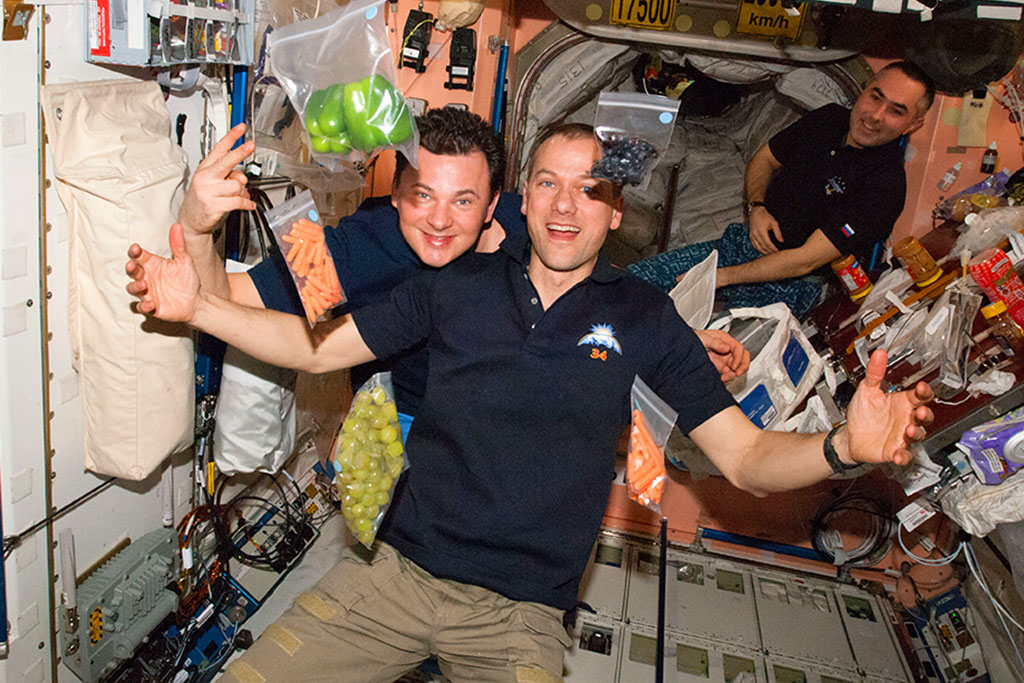
The Quest for Elevated Molecular Space Gastronomy
The difficulty of feeding people in microgravity conditions hasn’t stopped some big industry names from trying; award-winning chefs have spotted their next challenge and are ready to jump on board.
Michelin-starred culinary figures have prepared dozens of world-class meals for spaceflights and space tourism. For instance, French chefs Alain Ducasse and Thierry Marx curated an incredible list of dishes for the International Space Station (ISS), most recently for the French astronaut Thomas Pesquet. His selection includes almond tarts with caramelized pears, lobster, and beef bourguignon. Meanwhile, celebrated Spanish chefs Angel Leon and Jose Andres have been cooking up rice dishes including one cooked in fish collagen and flavored with freeze-dried plankton, and the beloved paella Valenciana.
The challenge presented to the space program, however, isn’t whether a Michelin-starred chef can prepare an exquisite meal for the ISS and space tourism while conforming to strict guidelines. Of course, they can. The real question is how can NASA create a self-sufficient system able to feed astronauts during deep-space missions?
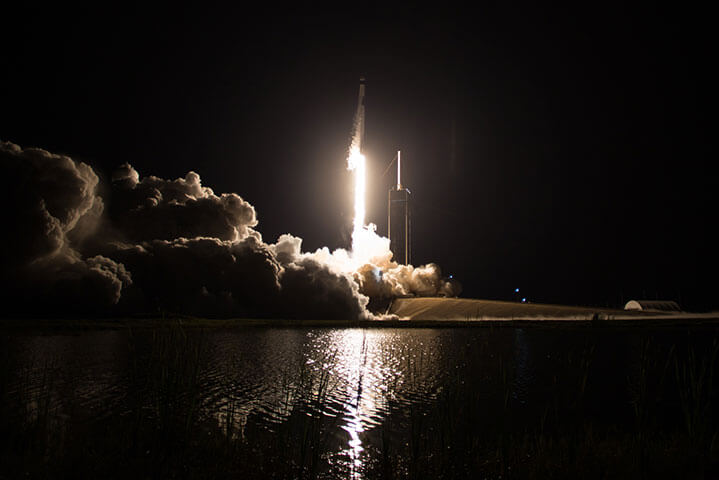
Next Stop, Mars?
The food we’ve come to associate with astronauts — dehydrated and vacuum-sealed heat processed meals delivered to the ISS — is wonderful for shorter trips and research. When it comes to sending our astronauts on longer missions in deeper space than we’ve ever ventured, we need to figure out a way for astronauts to self-reliantly produce food on the ship. Here are two examples of innovative foodservice research aimed at creating a sustainable and nutritious food source for astronauts on their deep-space adventures.
3D Printing
3D food printing is a culinary preparation technique still in its beginning stages. These printers pass food — ideally with the same consistency as frosting — through food-grade syringes that create layers of preprogrammed shapes. The shapes are created through droplets of food “ink.”
In the 2010’s, restaurants took notice of 3D printing, including one restaurant that only served printed dishes. As the emergence of Covid-19 put a damper on 3D restaurant printing, the trend has quieted for the time being. At this time, 3D-printed restaurant items are mainly found in fine dining establishments in Europe.
Restaurants aren’t the only sector gravitating towards printing food, however. 3D printing is also an incredible tool for the international space industry. With it, astronauts can print new bones, skin, habitats, tools, and now even deep-space nourishment. Taking raw materials from bioreactors, fermenting these byproduct ingredients, and mixing them with vitamins and flavors could be successful in bringing some of home with you while far from Earth.
With 3D printing making massive strides, we’re looking forward to seeing what scientists can devise for restaurants and for Mars.
Alternative Meat Production
Finnish company, Solar Foods, created a protein out of thin air called Solein. This technology uses a gas fermentation process similar to beer and winemaking.
A trip to Mars and back would take approximately three years. Storing three years’ worth of food upon takeoff isn’t manageable, due to size and weight restrictions. Solar Foods approached this problem by creating protein out of a natural, single-celled organism. Likewise, this process can be accomplished by astronauts on missions. During the production process, microbes feed off of the hydrogen and carbon dioxide gas found inside the fermenter.
This unconventional protein acts as a powder that can be mixed in with any other food. Adding Solein into any other food source is sure to give astronauts a health boost. According to the Solar Foods website, Solein contains:
- Protein: 65-70%
- Fat: 5-8%
- Fiber: 10-15%
- Mineral Nutrients: 3-5%
Stay tuned as Solein’s first pilot plant opens in 2023, for the ISS kitchen and earth-dwelling restaurants alike!
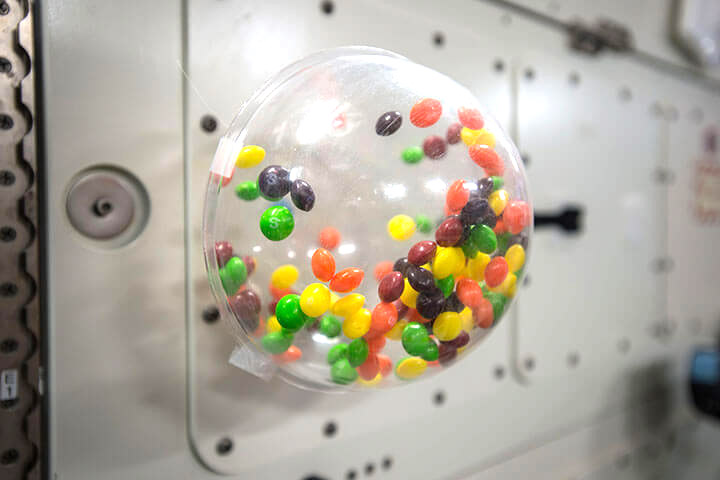
Out of This World Inspiration
While a trip to Mars feels light years away, progress is being made. The good news is, chefs who share a love for science can get involved. Periodically, NASA has been crowdsourcing ideas for nourishment using their Deep Space Food Challenge which promises to not only help astronauts, but people on Earth as well. Perhaps one of your menu items could work for space travel? Let those creative juices flow in the comment section below!

